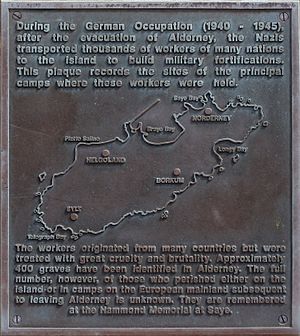Alderney camps facts for kids
The Alderney camps were a group of camps built by Nazi Germany on the island of Alderney during World War II. Germany occupied the Channel Islands at that time. These camps used forced labor, meaning people were made to work against their will. One of these, Lager Sylt, was the only Nazi concentration camp ever located on British soil.
Camps
In 1941, German military engineers built four main labor camps on Alderney. The Nazi group called Organisation Todt (OT) ran these camps. They forced people to work building strong defenses for Alderney. These defenses included bunkers, places for guns, air raid shelters, tunnels, and concrete walls. The camps started operating in January 1942. They were named after islands in Germany called the Frisian Islands.
The four camps on Alderney held about 6,000 prisoners in total. The exact numbers are hard to know because many records were destroyed. Studies in 2022 suggested there might have been as many as nine camps built on Alderney.
Two Work Camps
Two of the camps were known as "work camps":
The Borkum and Helgoland camps held "volunteer" workers. These workers were treated very harshly, but still better than the prisoners in the Sylt and Norderney camps.
Borkum camp held German technicians and "volunteers" from different countries in Europe. Helgoland camp was for Russian workers who were part of the Organisation Todt.
Two Concentration Camps
The other two camps became concentration camps. They were taken over by the SS from March 1, 1943. These became smaller parts of the Neuengamme concentration camp near Hamburg:
The prisoners in Lager Sylt and Lager Norderney were slave laborers. They were forced to build many military defenses all over Alderney. Sylt camp held Jewish people who were forced to work.
Norderney camp held European (mostly from Eastern Europe, but also some Spanish) and Russian forced laborers. In March 1943, both Lager Norderney (with Russian and Polish prisoners of war) and Lager Sylt (with Jewish prisoners) were put under SS control. SS officer Max List was in charge.
Deaths
More than 700 camp prisoners died before the camps closed in 1944. The remaining prisoners were moved to France.
There are 397 known graves on Alderney. People died from not having enough food, accidents, and cruel treatment. Some also died on ships bringing workers to or from Alderney. In January 1943, a big storm hit two ships in Alderney harbor. These ships, the Xaver Dorsch and the Franks, had about 1,000 Russian workers. They were stuck on the beach. Many workers died because they were kept locked in the ships' holds for two weeks while the ships were being saved.
On July 4, 1944, a tugboat called the Minotaure was sailing from Alderney to St Malo with about 500 workers. It was hit by torpedoes. About 250 people died, even though the ship stayed afloat and was towed to St Malo. Some escort ships were also sunk or damaged.
Documents from the ITS Archives in Germany show that prisoners from many different countries were held in Alderney. Many of them died on the island. The causes of death included lung infections, being shot, heart problems, and explosions. Detailed death certificates were filled out for these deaths.
Post-War Events
After World War II, a legal case was prepared against the former SS officer Max List for terrible acts on Alderney. However, he was never put on trial. He is thought to have lived near Hamburg until he died in the 1980s.
In 1949, a court in East Germany found an SS man named Peter Bikar guilty of crimes against humanity. He was sent to prison for five years for beating many prisoners.
The four German camps in Alderney have not been kept as they were. There is only a small plaque at the former SS camp Lager Sylt. One camp is now a place for tourists to camp. The entrance to another camp is now the island's rubbish dump. The other two camps have been left to fall apart and are covered by plants.
In 2017, some military writers suggested that between 40,000 and 70,000 slave workers had died at Alderney. They also claimed Alderney was a secret base for launching missiles with chemical weapons. These numbers were much higher than what other historians believed. The director of the Alderney museum said these estimates were "rubbish" and "utter nonsense." An archaeologist named Caroline Sturdy Colls also said there was "no evidence" for such high numbers of deaths.
Gillian Carr, a researcher at Cambridge University, studied the German occupation of the Channel Islands. Her findings were shown in an exhibition about the victims of Nazi persecution.
In 2019, a team led by Caroline Sturdy Colls visited Alderney to investigate for a TV show. However, the Alderney Government took back their permission for the team to dig at the Lager Sylt site. There were also concerns from the Jewish community about possibly disturbing human remains. In 2022, Sturdy Colls said her research suggested between 701 and 986 deaths.
In 2023, Lord Pickles, a UK official, ordered an investigation into the terrible acts committed in Alderney. A group of experts is gathering information and plans to share their findings in March 2024.
See also
- Fortifications of Alderney
- List of Nazi concentration camps
- List of concentration and internment camps
- Nazi concentration camps
- World War II


